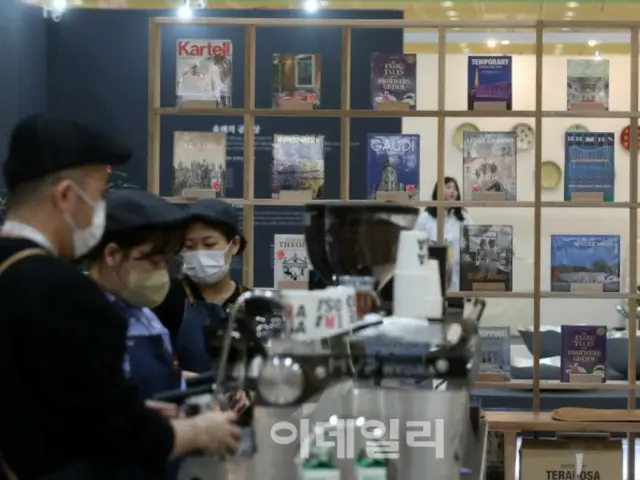When asked about the reasons for the increase in the number of coffee shops, an industry insider said that as homes have become smaller, cafes have become popular places to chat with friends and acquaintances, and that the coffee contains
They cited a number of reasons for this, including the addictive nature of the caffeine contained in the beverage, which has led to increased consumption, and the fact that it is possible to start a business with little capital, making it easy to get into the industry.
It is said that the average amount of coffee consumed by Korean adults per year is about three times the world average, and Korea is one of the world's leading "coffee"
Coffee was first introduced to Korea in 1896 by Madame Antoinette So, the sister-in-law of the first Japanese envoy to Russia, Weber (1841-1910).
There is a record of Ntag presenting coffee to Emperor Gojong, who ruled Korea at the time. It is said that Emperor Gojong was well acquainted with coffee even before this. In the midst of political turmoil,
For a time, King Gojong lived in the Russian embassy to protect himself, and Sontag served as his attendant. He gave Sontag a house. The house was remodeled in a Western style and turned into a meeting hall, with a first floor.
A restaurant and cafe was set up in the building. This is said to be the first cafe in Korea. At the time, coffee was something only the upper class could afford, but in the 1960s, the term "coffee shop" came into use.
Tabangs (tea houses) were opened to the middle class. Cultural figures and artists gathered in the tabangs, and they played an important role in connecting people with various purposes.
In the 1980s, taverns became places for people to meet and meet, and also became a popular culture hub where artists performed. In the 1980s, competition among taverns intensified.
Cafes that serve coffee by hand also appeared during this period. Coffee consumption in Korea increased sharply in the late 1990s, and competition between cafes became even more intense.
Starbucks opened its first store in South Korea in Seoul. South Korea's cafe market is the third largest in the world after the United States and China, but downtown cafes have been hit hard by the COVID-19 pandemic.
Meanwhile, during the self-isolation period, "dalgona coffee," which is made by putting coffee cream on top of milk, became popular. "Dalgona" is a Korean word for a sweet similar to caramel candy, and the appearance of this coffee was similar to that of the "dalgona" coffee.
It is said that the name "Dalgona Coffee" was given to it because of its similar taste and texture. During the self-restraint period due to the COVID-19 pandemic, more and more people enjoyed making Dalgona coffee at home, and photos and videos of them were posted on social media.
Once it spread, it became popular around the world. In English, it is called Dalgona Coffee, just like the Korean name, and in a cafe in Sweden, it is on the menu under the name "Dalgona".
As if to ride on this boom, Nongshim, a major Korean food manufacturer well known in Japan for its "Shin Ramyun," has launched a snack called "Chol" that resembles a solidified version of Baby Star Ramen.
The dalgona flavor of "Bing" was released and became a hot topic. During the COVID-19 pandemic, the number of customers coming into the store to drink coffee dropped dramatically, but delivery services increased, and the major newspaper JoongAng Ilbo wrote in an article in March 2021 that
According to Idiya Coffee, a coffee delivery service, delivery sales in December last year, when the third wave of COVID-19 was at its peak, increased 57% from the previous month to a record high.
Orders are concentrated between 11 a.m. and 2 p.m. and 5 p.m. and 8 p.m. This reflects the characteristics of existing customers who visit the store around lunch and dinner times.
" After the COVID-19 pandemic, Korean coffee shops have seen a steady recovery as customers returned to them. The growth of the coffee market can also be seen in the increase in the import value of coffee (green beans and roasted beans), and the Korea Customs Service
According to import and export trade statistics, the total value of coffee bean imports last year was $1.11 billion, exceeding the $1 billion mark for the second consecutive year. This is 1.7 times the figure five years ago and 2.7 times the figure 10 years ago.
According to the Korea National Statistical Office, the number of coffee shops nationwide will be 107,290 as of 2022, up 4.5% from the previous year and exceeding 100,000.
"The reason for the sudden increase in the number of coffee specialty stores is that they are a typical industry that can be opened with little capital, do not require special skills, and are easy to enter," he analyzed.
There are some who believe that the number of stores has increased so much that the market will soon reach saturation point."
2024/07/02 13:12 KST
Copyrights(C)wowkorea.jp 2

